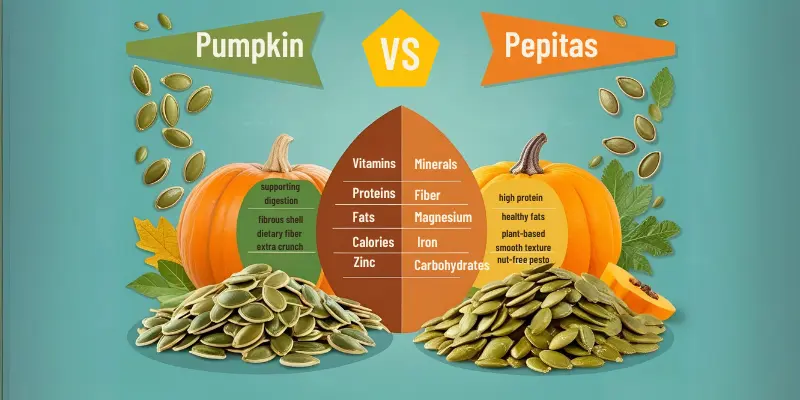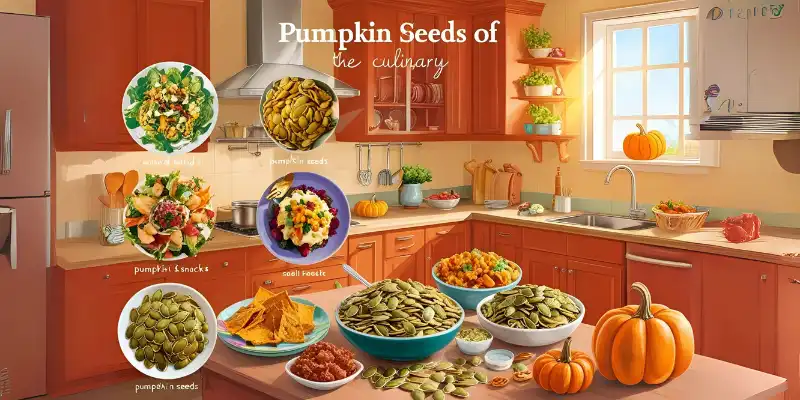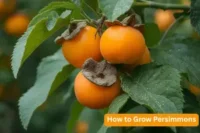Pepitas vs. Pumpkin Seeds: What’s the Real Difference?
Published: 13 May 2025
Hello, Seed Explorer!
Do you ever wonder if pepitas and pumpkin seeds are the same thing? They might look alike, but they come from different types of pumpkins and serve various purposes. Pepitas vs. pumpkin seeds is a common kitchen mystery that often confuses health lovers and home cooks. While pepitas are green and shell-free, pumpkin seeds have a white shell and a different crunch.
I’m Sheila, a botanist with seven years of hands-on experience studying seeds and plants. In this article, I will explain the differences between pepitas and pumpkin seeds, covering nutrition, cooking uses, gardening tips, and fun trivia.

By the end, you’ll know exactly which seed to pick for your salad, soup, or seed mix. Let’s explore these small but mighty seeds and unlock their full potential together.
Pepitas vs Pumpkin Seeds: Understanding the Difference
Pepitas and pumpkin seeds may seem interchangeable, but they are as different as apples and pears. Both come from pumpkins, yet their origin, appearance, and use tell separate stories. In my gardening journey, I once grew Styrian pumpkins to harvest pepitas, and the experience showed me how unique these little seeds truly are.
| Feature | Pumpkin Seeds | Pepitas |
| Origin | From various pumpkin varieties commonly used for carving or cooking | From specific hull-free varieties like Styrian or oilseed pumpkins |
| Shell presence | No, naturally, shell-free | No, naturally, shell free |
| Appearance | Oval, hard, white or cream-colored | Flat, smooth, green |
| Texture | Crunchy when roasted, firm due to the outer shell | Softer, tender, with a mild nutty flavour |
| Harvest note | Typically scooped from the inside of pumpkins after cutting | Grown specifically for edible seeds, easy to process |
| Culinary use | Best for roasting whole, adding crunch to snacks or baking | Ideal for salads, pesto, baking, and traditional dishes like mole |
| Gardener tips | Needs cleaning and drying if harvested at home | Grows best from hull-free seed varieties like ‘Kakai’ or ‘Lady Godiva’ |
| Cultural insights | Common in many cultures during fall celebrations | Popular in Mexican and European cuisine, especially in seed oils and sauces |
Nutritional Comparison
Choosing between pepitas and pumpkin seeds is like choosing between two powerhouses at the gym; each has unique strengths that can support your health goals differently.
When I added both to my morning smoothies and salad bowls, I noticed how their nutrient profiles complemented my energy and digestion.
Macronutrients
| Pumpkin seeds | Pepitas |
| With their fibrous shell, pumpkin seeds offer more dietary fiber, around 5 grams per serving. That extra crunch also adds bulk to your meals, helping you stay full longer and supporting digestion. | Pepitas are high in protein and healthy fats. Due to their 25 grams of protein per 100 grams, they are popular with plant-based athletes and fitness enthusiasts. Their smooth texture makes them perfect for blending into protein balls, nut-free pesto, or vegan sauces. |
Micronutrients
Both pepitas and pumpkin seeds are excellent sources of essential minerals.
- They deliver impressive amounts of magnesium (which supports muscle and nerve function), zinc (great for immunity), and iron (key for energy production).
- I recommend adding a spoonful of raw pepitas to oatmeal or yoghurt for a nutrient-packed start to the day.
Culinary Uses
Think of pumpkin seeds and pepitas as versatile ingredients that play different roles in your kitchen, just like spices in a well-loved recipe.

Personal Experience: I’ve used both in everything from hearty soups to sweet energy bites, and each adds its flair to the dish.
Pumpkin Seeds
- Pumpkin seeds are usually roasted with a sprinkle of sea salt and eaten as a crunchy snack. Their firm shell gives them a bold texture that works beautifully in granola bars, trail mixes, and even on top of baked bread.
- They’re also a great addition to autumn-inspired salads or used whole as a topping for roasted vegetables.
Pepitas
- Pepitas are a star ingredient in Mexican cuisine. They’re famously used in traditional sauces like mole, where their nutty flavour adds depth and richness.
- Their shell-free, smooth texture makes them perfect for blending into green pesto or smoothie bowls.
- I often toss a spoonful into homemade soups for a final touch or sprinkle them on avocado toast for added crunch and nutrition.
| Trivia Time: Did You Know? |
|---|
Pepitas are a culinary staple in Mexican cuisine, dating back to the Aztecs, who used them in sauces, soups, and even as offerings during rituals. The term “pepita” literally means “little seed of squash” in Spanish, and it specifically refers to the green, shell-free seeds from hull-free pumpkins. One ounce of pepitas contains nearly 40% of your daily magnesium needs, making them one of the most magnesium-rich foods you can eat naturally. |
Gardening Insights
- Growing your pepitas or pumpkin seeds is like nurturing a treasure chest of nutrition right in your backyard. As a home gardener, I’ve found it incredibly rewarding to plant varieties that beautify the garden and feed the family.

- If you’re specifically after pepitas, go for hull-free pumpkin varieties like Lady Godiva or Kakai. These pumpkins are bred for their edible, shell-free seeds, making the harvest process much easier and cleaner. I once grew Kakai in a raised bed, and the yield was generous, not just in seeds but also in satisfaction.
- These pumpkins thrive in full sun, rich soil, and warm climates. With care and regular watering, you’ll enjoy vibrant vines that reward you with delicious green seeds ready to toast or toss into your favorite dishes.
| Possible Drawbacks to Consider |
|---|
High-Calorie Density: Although nutritious, both pepitas and pumpkin seeds are calorie-dense. Overeating can easily lead to excess calorie intake, especially when flavoured or roasted with oil. Risk of Allergies: Seed allergies are infrequent and can cause mild to severe symptoms. Introducing them gradually is best, especially in children or sensitive individuals. Phytic Acid Content: Like many seeds, pumpkin seeds and pepitas contain phytic acid, an anti-nutrient that can hinder the absorption of iron and zinc. Soaking or roasting them may reduce this effect. |
Final Verdict
When we break down pepitas vs pumpkin seeds nutritionally, both shine in their own right. With their fiber-rich shells, pumpkin seeds support digestion, while pepitas pack a protein punch that’s great for plant-based diets.
Consider incorporating both into your meals in balanced ways. They’re backed by science and taste-tested in home kitchens like mine. Whether garnishing your soup or planting your first hull-free pumpkin, these seeds are in your wellness journey.
→ Want more nutritious insights straight from the garden to your table? Subscribe and join the seed wisdom journey today!
Frequently Asked Questions
Are you curious about how to use, grow, or buy pepitas and pumpkin seeds? These quick answers will help you clear up common doubts and get the most from these nutritious seeds.
Not exactly. All pepitas are pumpkin seeds, but not all pumpkin seeds are pepitas. Pepitas come from specific hull-free pumpkin varieties and are naturally green, while most pumpkin seeds have a white shell around them.
Yes, you can eat pumpkin seeds raw, especially if they’re clean and fresh. However, roasting enhances flavour and crunch. Lightly toasting them with a bit of sea salt makes a great snack!
Look for green, shell-free seeds explicitly labelled as “pepitas.” Unless stated otherwise, most store-bought pumpkin seeds still have the white shell on. Always check the packaging for the seed variety.
Both are highly nutritious but differ slightly. Pepitas offer more protein and healthy fats, while whole pumpkin seeds have more fiber due to the shell. It depends on your dietary goals.
Yes! Choose hull-free varieties like Kakai or Lady Godiva, which are specifically bred for edible seeds. They’re easy to grow in sunny spots and give a rewarding harvest by late summer or fall.
Please keep them in an airtight container in a cool, dry place. For longer freshness, store them in the fridge or freezer. This prevents them from going rancid due to their natural oils.
Yes, pepitas are generally safe and nutritious for kids, especially since they’re shell-free and easier to chew. Just be mindful of portion size and always watch younger children while eating seeds.
Yes, pumpkin seeds are rich in magnesium and tryptophan, which may promote better sleep and mood. Enjoying a handful before bedtime is a simple, natural way to support relaxation.
You can find pepitas at health food stores, bulk seed shops, or online retailers. If possible, look for raw, organic options. I recommend checking local farmers’ markets for the freshest seeds.
Absolutely! Pepitas are great in muffins, bread, granola bars, or sprinkled on cookies. Their mild, nutty flavour adds crunch and nutrition to sweet and savoury recipes.

- Be Respectful
- Stay Relevant
- Stay Positive
- True Feedback
- Encourage Discussion
- Avoid Spamming
- No Fake News
- Don't Copy-Paste
- No Personal Attacks

- Be Respectful
- Stay Relevant
- Stay Positive
- True Feedback
- Encourage Discussion
- Avoid Spamming
- No Fake News
- Don't Copy-Paste
- No Personal Attacks





